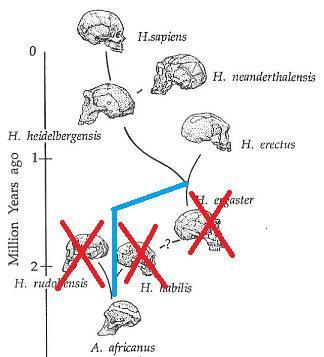Last year Dmanisi, in Georgia, made headlines when a new fossil human skull (known as D4500, or skull 5 by people who want to have to remember less numbers) was discovered. Skull 5 dates to around 1.8 million years ago, making it one of the first members of our family to have left Africa1. But that’s not why it made headlines. No, skull 5 is important because all the other skulls found at the site (imaginatively labelled skulls 1 – 4) and the skeleton of skull 5 look like Homo erectus but skull 5 resembles their cousin, Homo ergaster. Could it be that H. ergaster and H. erectus were the same species after all2?

The classic human family tree (modified in light of the new Dmanisi discovery)
That was the conclusion of the original paper on skull 5, which trimmed a few branches from the human family tree2. However, there were murmurs of dissent from other researchers. But science is thorough, rigorous and slow; so only now are we beginning to see their contradictory research. The first volley in this Dmanisi debate can be found in PLoS One so is free to access. But don’t be too tempted to abandon this post and go read it yourself, it’s some rather dense stuff.
This new research examines the jaw of skull 5 and one from another of the Dmanisi skulls (a subadult, likely in their late teens when they died3). As I just said, skull 5 is a bit of an odd one out amongst the Dmanisi specimens, a fact which could be explained by sexual dimorphism, or perhaps that skull 5 is of an larger individual than the others. To test the validity of these explanations, the team focused on traits which develop early in the life of an individual. Sexual differences often accrue during puberty and differences that result from size are obviously linked to growth. As such these early traits should theoretically be similar between these two jaws, if their differences are indeed the result of these two explanations.
Except this team found almost the exact opposite. Many of these early traits showed significant differences between the two jaws. What’s more, the two jaws appear to have undergone different trajectories of growth. For example, the skull 5 mandible has a larger area of bone behind the teeth, which seems to indicate it was growing for a longer time than the subadult skull. As such, the researchers argue that these jaws are fundamentally different, so the two skulls should be classified as different species of human. In support of this, they also cite the fact the two individuals come from different layers at Dmanisi. Although they were formed shortly after one another, enough time passed between them (~10,000 years) where a new species could have migrated in and replaced the existing group4.

The two jaws from Dmanisi being examined. The new one (left) and the subadult (right)
Now, those of you with a keen eye might have noticed some problems with this method. Like the fact they’re comparing growth patterns between two individuals when one hasn’t finished growing. Those of you with a good memory might also recall a post from the dark ages of EvoAnth which discussed research showing that human jaw can vary considerably from person to person depending on their diet. And there’s also the fact that skull 5′s jaw has changed to compensate for toothwear, which would no doubt influence the results of any comparison of jaws.
The researchers do try and circumvent some of these issues. They note that the changes to the jaw are likely small, and since they’re examining traits which develop early the different ages shouldn’t be an issue4. But I think the real kicker is the variation in human jaws. They also try and solve this problem too, by noting that the difference between the two jaws at Dmanisi are greater than the differences between any human jaws. But then, most humans have been shifting to an agricultural diet, so I suspect that we might have relatively little variation, compared to most other members of our family. And whilst the jaws are quite different, the overall skulls are no different than two human skulls2.
This new paper does a good job of showing there are some fairly fundamental differences between the two Dmanisi skulls, but I don’t think they rule out enough potential sources of variation (and there are a few niggling little problems with their methodology) to justify their ultimate conclusion. The weight of evidence still suggests that there is just one species at Dmanisi, although that weight is sitting on a slightly less firm foundation. It will be interesting to see how – or if – the original researchers respond.
References
- Gabunia, L., & Vekua, A. (1995). A plio-pleistocene hominid from Dmanisi, East Georgia, Caucasus. Nature, 373(6514), 509-512.
- Lordkipanidze, D., de León, M. S. P., Margvelashvili, A., Rak, Y., Rightmire, G. P., Vekua, A., & Zollikofer, C. P. (2013). A complete skull from Dmanisi, Georgia, and the evolutionary biology of early Homo. Science, 342(6156), 326-331.
- Vekua, A., Lordkipanidze, D., Rightmire, G. P., Agusti, J., Ferring, R., Maisuradze, G., … & Zollikofer, C. (2002). A new skull of early Homo from Dmanisi, Georgia. Science, 297(5578), 85-89.
- de Castro, J. M. B., Martinón-Torres, M., Sier, M. J., & Martín-Francés, L. (2014). On the Variability of the Dmanisi Mandibles. PloS one, 9(2), e88212.

